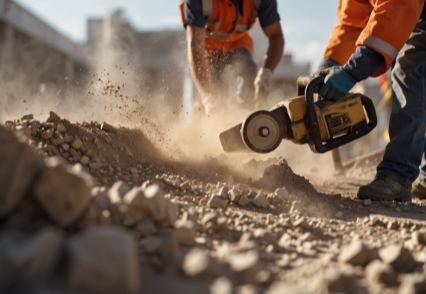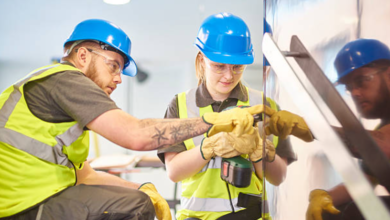The Secret to Faster and Easier Concrete Jobs

Concrete work can be demanding, time-sensitive, and intricate, making efficiency a top priority for professionals in the construction field. From preparing surfaces to delivering and pouring material, every step in the process presents opportunities for improvement. By leveraging the right techniques, tools, and strategies, you can achieve faster, easier concrete jobs without compromising quality. Here’s a closer look at how to optimize your efforts in concrete-related tasks.
Start with Proper Site Preparation
A successful concrete job always starts with a well-prepared site. This includes clearing debris, leveling the area, and ensuring the ground is adequately compacted. A poorly prepared surface can lead to uneven pours, cracking, and weakened structures over time.
- Clear the Area Fully: Removing rocks, roots, and other obstructions ensures a clean slate for your work.
- Level and Compact: Use tools like a tamper or vibrating plate compactor to create a solid, even base for the concrete.
- Determine Proper Drainage: Plan for water flow and install drainage systems as needed to prevent future erosion issues.
By dedicating time to preparation, you reduce the risk of errors and rework, ultimately saving time in the long run.
Optimize Your Mixing Process
The mixing process is where efficient workflows can make a significant impact. Whether you’re working with a small batch or a larger project, consistency and timing are critical.
- Choose the Right Ratios: Follow established mix ratio guidelines to ensure proper strength and durability. A sloppy ratio can lead to weak or brittle concrete.
- Mix Only What You Need: Overproducing concrete can lead to waste and delays. Calculate the required volume carefully based on project dimensions.
- Use Efficient Mixing Equipment: Portable mixers or automated systems help you achieve consistent mixes faster. These tools allow for quicker blending and easy portability to your pouring location.
Maintaining consistency at this stage ensures better results while helping you avoid unnecessary delays.
Invest in Time-Saving Tools and Equipment
Streamlining your processes often starts with the tools you use. Investing in modern, efficient equipment tailored to your needs can drastically reduce the time spent on a project.
- Power Screeds: For leveling wet concrete quickly and uniformly, power screeds are invaluable. They save hours compared to manual screeding.
- Concrete Vibrators: These tools are critical for removing air pockets, ensuring smooth finishes, and higher strength.
- Specialty Forms: Modular or reusable forms can make shaping and structural work easier, providing both time and cost savings.
Among these tools, a concrete trailer can be particularly useful for transporting materials quickly and efficiently, especially for larger projects or challenging terrains.
Streamline Pouring and Placement
Concrete pouring and placement require careful attention to detail, but they also present opportunities for improving efficiency.
Use Pre-Planned Pouring Strategies
Proper planning before the first pour improves accuracy and minimizes interruptions. For instance, designate key points for starting and finishing pours, and ensure all equipment is set up near the pour site in advance.
Assign Clear Roles
When working as part of a team, assigning specific roles—like mixing, pouring, and smoothing—streamlines the overall process. Clear communication ensures everyone stays on task.
Work in Sections
For larger jobs, dividing concrete pours into manageable sections prevents premature drying and allows for neater results. Use dividers or joints to segment the space effectively.
By adopting structured methods during pouring, you minimize mistakes, save time, and ensure a higher-quality finish.
Improve Curing and Finishing Steps
Proper curing and finishing are crucial for durability and appearance. Cutting corners at this stage can compromise your entire project. However, you can still save time while delivering excellent results.
- Curing Tricks: Use curing blankets or plastic sheeting for even moisture retention, especially in hot or windy conditions that can speed up drying. These techniques maintain hydration, improving the material’s strength over time.
- Efficient Joint Placement: During finishing, ensure contraction joints are installed promptly to prevent cracking. Tools like joint cutters make this process quicker and more precise.
- Surface Finishes: For large-scale projects, tools such as ride-on trowels expedite the surface smoothing process.
Each detail in the curing and finishing stage strengthens your outcome while helping to stick to your timeline.
See also: Edge Detection and Object Isolation Techniques: A Guide to Cleaner Visuals
Plan for Maintenance and Durability
Although concrete jobs conclude with curing and polishing, maintenance considerations should be part of your long-term plan. A strong structure with minimal upkeep saves on future repairs, boosts project lifespan, and ultimately supports client satisfaction.
- Apply Sealants: Sealants protect concrete from moisture, stains, and environmental wear. They’re especially valuable for high-traffic areas.
- Monitor Wear and Tear: Address small cracks or damage before they worsen. Quick intervention can prevent considerable time and cost down the line.
- Educate End Users: Provide guidance on how to maintain their concrete surfaces effectively. Small actions like regular cleaning or reapplying sealants can extend the material’s longevity.
By emphasizing durability and proactive care, you can ensure that your concrete work remains a reliable investment for years to come.





